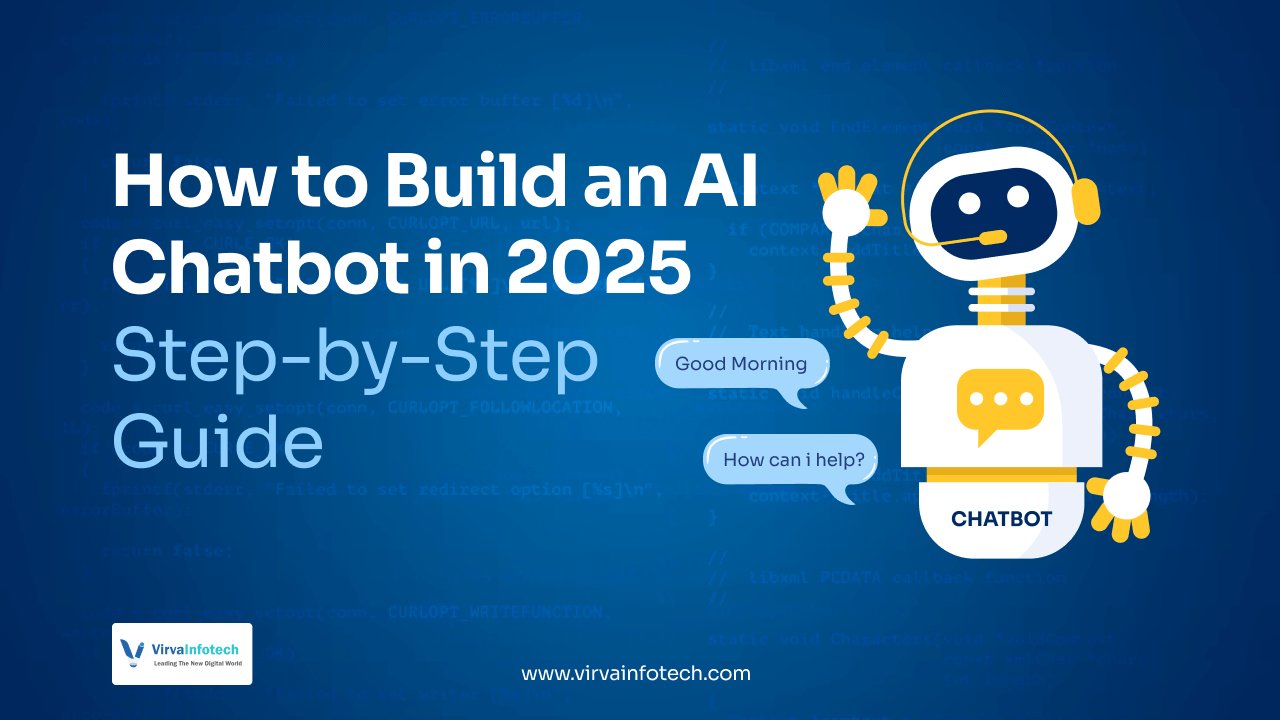Posted At: Jun 03, 2025 - 485 Views

The use of AI chatbots in daily life and business has become widespread, surpassing their popularity in 2025. The use of AI-powered chatbots is transforming the online experience, with users providing personalised responses and assistance in making their own decisions.
ChatGPT, Google Gemini, and voice AI have made it possible to create a chatbot that is both intelligent and responsive, making the task more accessible even for those with little coding expertise. Discover all the essential details about developing an AI chatbot in 2025, as outlined in this blog.
What Are AI Chatbots?
Artificial Intelligence (AI) chatbots are computer programs designed to mimic human-like conversations. Unlike traditional chatbots, which are pre-designed with artificial intelligence and Natural Language Processing (NLP) to understand the user's question better and answer it intelligently, AI chatbots use these same principles to do what they do.
Market Overview of AI Chatbots
The use of AI chatbots is on the rise in the market as businesses rely on them to improve customer experience and automate communication.
- The global chatbot market's value was estimated to be USD 5,132.8 million in 2022
- The CAGR expected in the period from 2023 to 2030 is 23.3%
The integration of AI and chatbots into customer experience is being prioritised by 72% of business leaders in a new survey over the next year.
The advancement of chatbot technology is increasing user satisfaction:
- Nearly 80% of customers have had positive experiences with chatbots.
Chatbot Consulting Services provides specialised assistance, customised solutions and ongoing optimisation to ensure smooth implementation by many companies.
How AI Chatbots Work
AI chatbots (also called conversational bots) are smart programs that can understand what people say and reply in a human-like way. These chatbots use a mix of technologies like Natural Language Processing (NLP), Machine Learning (ML), and sometimes Deep Learning to work properly.
1. Natural Language Processing (NLP)
AI's NLP function enables the chatbot to comprehend human language, such as English, Hindi, or any other language. This is done through artificial intelligence.
It involves:
By means of tokenisation, sentences can be broken down into words or short phrases.
Parsing helps in comprehending sentence structure (such as subject, verb, object)
NER is the process of discovering significant words such as names, dates, and locations.
Assessing whether the user's message is marked as happy, angry or sad by conducting a sentiment analysis.
2. Machine Learning (ML)
Chatbots can learn from past exchanges using Machine Learning. With more interaction with people, the bot becomes more intelligent.
Main things involved:
Training Data – Chatbots are trained on lots of example chats
Supervised Learning – The bot learns using correct question-answer pairs
Reinforcement Learning – The bot improves by getting rewards for good replies and penalties for wrong ones
3. Dialogue Management
Dialogue Management controls the flow of conversation between the user and the chatbot. It helps maintain context, track conversation history, and managemulti-turn dialogues. This ensures that the chatbot responds in a coherent, relevant, and human-like manner, even during complex or extended interactions.
4. Ethical Considerations in AI Chatbots
To ensure the safe, impartial, and ethical use of AI chatbots, it's crucial to consider ethical considerations. Neglecting such concerns may lead to diminished trustworthiness, legal complications and a deficient user experience.
Here are the key ethical concerns:
1. Bias and Fairness
AI chatbots should give neutral and unbiased responses. If the chatbot is trained on biased data, it may give unfair answers or promote stereotypes. Developers must test and update the chatbot regularly to make sure it's fair and inclusive for all users.
2. Privacy and Data Protection
User privacy is a top concern. AI chatbots often collect personal information like names, emails, or chat history. This data must be stored securely and follow rules like GDPR or data protection laws. Always ask for user consent before collecting data and avoid sharing it without permission.
3. Transparency
Users should always know that they are talking to a bot, not a human. The chatbot must clearly introduce itself as an AI or virtual assistant. Being transparent builds trust and helps avoid confusion or misleading interactions.
How Are AI Chatbots Made?
Creating an AI chatbot involves a few important steps to make sure it works well and helps users properly. Here’s how it’s usually done:
Step 1: Decide What the Chatbot Will Do
Start by figuring out why you're making the chatbot.
Who will use it? What problems should it solve? Make sure you’re clear about the goals.
Step 2: Pick the Right Tools
Choose the software and tools needed to build it.
This includes selecting an AI or language platform (like Rasa, Dialogflow, or IBM Watson), and deciding where the chatbot will be used — like on a website, in an app, or chat services like WhatsApp or Messenger.
Step 3: Plan the Chat
Think through how the conversation should go.
List out what users might ask and how the bot should reply. The goal is to make the conversation smooth and helpful.
Step 4: Build and Teach the Chatbot
Start coding and building the system behind the chatbot.
Train it with examples so it can understand what users mean and reply correctly. You might need to connect it to databases or other services, too.
Step 5: Test and Improve
Try the chatbot in different situations to see how it performs.
Fix any issues and update it based on feedback to make it smarter and more accurate.
Step 6: Launch and Keep an Eye on It
Put the chatbot live on your chosen platform
Use monitoring tools to track how it's doing, check how people are using it, and keep improving it over time.
Types of AI Chatbots
1. Rule-Based AI Chatbots
AI chatbots are based on rules and are the most basic form of them. Pre-defined logic and pre-existing rules are used by them to respond to users. These bots seek out particular keywords or phrases in an email and provide predetermined answers. They're perfect for simple tasks like answering FAQs, providing quick instructions, or guiding users through a basic decision tree. Their ability to handle intricate or ambiguous inquiries is restricted to the guidelines established by developers, making them inept at doing so.
2. Machine Learning-Powered Chatbots
AI chatbots use ML and NLP to interpret input from users. Through conversations and user behaviour, they improve over time. These bots are suited for answering complex questions, adapting to different user preferences, and providing more tailored responses. Their applications include customer service, virtual assistants, and apps that require intelligent and human-like interactions. They're also widely used.
3. Hybrid AI Chatbots
Hybrid chatbots combine the best of both worlds — rule-based logic and AI learning. They use rules for clear, structured tasks and switch to AI-based responses when things get more complex or dynamic. This allows them to maintain control in critical situations while still offering flexibility and intelligence. Businesses often choose hybrid bots when they need both accuracy and adaptability in their chatbot systems.
4. Task-Oriented Chatbots
User assistance is the primary objective of these AI chatbots. Users can easily manage their orders, schedule a meeting, or order by using these bots. These applications are highly focused on achieving specific objectives and are frequently utilised in e-commerce, healthcare, travel, and banking apps, where user actions are necessary.
5. Conversational AI Assistants
Conversational AI chatbots are the most advanced type of chatbot. They can hold open-ended conversations, understand context, and even remember previous chats to provide more relevant answers. These bots use advanced NLP, deep learning, and even voice recognition to interact with users just like a human would. Examples include Siri, Alexa, and Google Assistant. They are used in smart devices, virtual assistant apps, and voice-controlled technology.
6. Social Media Chatbots
Social media chatbots function within messaging apps such as Facebook Messenger, WhatsApp, or Instagram. Businesses can connect with users instantly by using bots, which can respond to queries, provide customer service, share product information, and even participate in marketing campaigns. Brand engagement can be a potent force, especially for companies that aim to be accessible 24/7 on platforms they use daily. This is particularly advantageous for brands.
Top AI Chatbot-Building Platforms for 2025
1. Dialogflow (by Google)
A chatbot platform called Dialogflow, created by Google, is widely used. Its simplicity and processing power enable chatbots to comprehend the user's intent and context through natural language processing (NLP). This application is suitable for creating voice and text-based chatbots and can be integrated with apps such as Google Assistant, Slack, and Facebook Messenger. Dialogflow is a useful tool for businesses that desire conversations that are context-sensitive and can be quickly deployed.
2. Microsoft Bot Framework
The Microsoft Bot Framework is a versatile and potent .NET or Node.js framework for developing AI chatbots. Services like Bot Services and language understanding (LUIS) are made available through seamless integration with Microsoft Azure. The ability to integrate with a range of channels, including Microsoft Teams, Skype, and web apps, is advantageous for enterprise-level chatbot solutions.
3. IBM Watson Assistant
The capabilities of IBM Watson Assistant are a testament to its impressive AI.' The application of machine learning and advanced NLP enables it to comprehend user questions with the intelligence of a mind. You can connect Watson Assistant to your website, mobile application or chat platforms such as WhatsApp and Messenger. This is a great option for companies seeking advanced AI chatbot software with precise control and analytics.
4. Amazon Lex
Amazon Lex is a product of the AWS family that employs the same speech recognition and NLP technology as Alexa. Developers can build complex and scalable applications using it as the foundation for creating voice-enabled chatbots and its deep integration with AWS services. The software also includes functions to handle chatbot interactions, session management and personalised feedback.
5. Rasa (Open Source)
Developed by Open-Source developers, chatbots like Rasa can control their behaviour and data. The system is a good fit for businesses that require custom AI chatbots and want to host them on their server infrastructure. Advanced NLP, multi-turn conversations and machine learning models are supported by Rasa. It is most appropriate for developers who are comfortable with coding and want high flexibility.
6. Wit.ai (by Facebook)
A free and uncomplicated NLP platform called Wit.ai was developed by Facebook, among other things. It enables you to transform user speech or text into structured data. Wit.ai is compatible with multiple languages and can be used alongside Facebook Messenger, Slack, and other messaging apps. Developers can choose this option if they want to develop chatbots that are multilingual and have basic natural language comprehension capabilities.
How Much Does it Cost to Develop an AI Chatbot?
The cost to develop an AI chatbot depends on how advanced the chatbot is and what features you need. A basic rule-based chatbot, which follows fixed commands or keywords, can be created using free chatbot platforms and usually costs around $0 to $500. These are good for answering simple questions or doing small tasks. On the other hand, a more advanced AI chatbot with NLP (Natural Language Processing), which can understand and respond to natural human language, may cost between $1,000 and $10,000. These are better suited for customer service, virtual assistants, or apps that need more intelligent responses.
For businesses that need more powerful solutions, a custom chatbot with integrations, such as connecting to payment gateways, CRMs, or other APIs, can cost anywhere from $10,000 to $100,000 or more. Apart from the development cost, companies should also consider other expenses like API usage fees (for example, ChatGPT token costs), server or cloud hosting, ongoing maintenance, software updates, and third-party integration costs. Planning the full AI chatbot development budget is important to ensure your chatbot performs well and scales with your needs.
What Is the Future of AI Chatbot Development?
Better Understanding of Emotions
Future AI chatbots will have stronger emotional intelligence. They will understand not just the words, but also the feelings behind what users say. This will help chatbots give more empathetic and human-like responses.
Multimodal Interactions
Multimodal communication through chatbots will be made possible by the integration of voice, text, and visual interface. Users can communicate with bots more naturally, using the easiest available means.
Integration with IoT Devices
The integration of AI chatbot technology with IoT devices, such as smart lights, security systems, and home assistants, will be enhanced. Users can now control their smart home devices using chatbot commands.
Chatbots in Virtual Reality (VR)
In the future, AI chatbots will be part of VR environments, acting as intelligent guides or virtual assistants in games, simulations, or training tools. They will respond to user actions in real time, creating more immersive experiences.
More Personalization
AI-powered chatbots will offer more personalised experiences by learning from user behaviour and preferences. They will be able to predict user needs and offer help before the user even asks for it.
Conclusion
AI chatbots in 2025 are smarter, faster, and easier to build than ever before. Whether you’re a small business owner, content creator, startup founder, or developer, building a chatbot is now within your reach.
Just define your goals, pick the right platform, and follow a clear development plan. With the right AI chatbot, you can save time, serve your customers better, and grow your business 24/7 — without hiring extra staff.
So don’t wait. Start building your AI chatbot today and stay ahead in the digital future.


